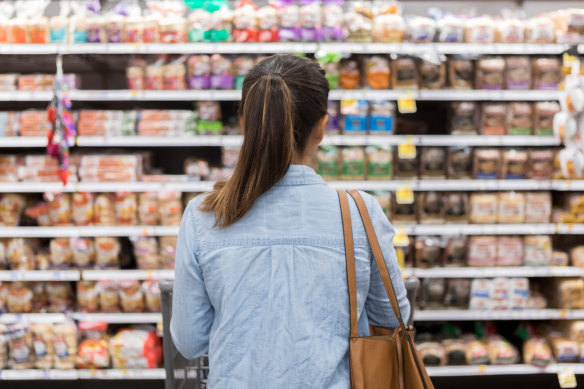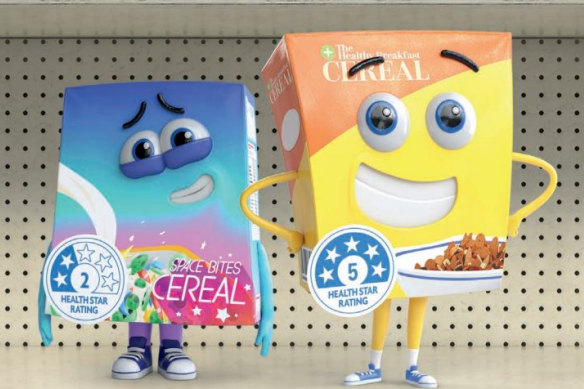This was published 4 years ago
Food labels can make you healthier, without you even realising
Health star ratings on food packaging don’t just help consumers make better choices, they've also now been proven to encourage manufacturers to switch to healthier ingredients to bump up their score, prompting calls for the system to be mandatory.
A new study, published on Saturday in PLOS Medicine, found that compared to Australian products that don't display a health star rating, those that do are 6.5 per cent more likely to have their nutrition improved and increase their score by 0.5 stars.

The health star rating system is designed to help consumers compare products more easily. Credit: iStock
It may appear small, but this figure would be higher if unhealthy packaged products were all forced to display a rating, says Dr Laxman Bablani, the study's lead author and a University of Melbourne research fellow.
Less than 15 per cent of unhealthy products chose to display the health star label in 2019, compared to more than 35 per cent of healthy products.
To observe how product formulation changed, researchers from Australia and New Zealand tracked the nutrition information of almost 59,000 products in major supermarkets since 2014 – the year the voluntary health star rating system, which gives packaged foods a score out of five stars, was introduced nationally as a way to help busy shoppers make quick but healthier choices.
The team used the official health star calculator to score products that didn't display a rating.

An Australian government ad for the health star rating.
Unhealthy products that showed a rating had the most ingredient reformulation. On average, a product that scored 0.5-1.5 stars had its kilojoules decreased by 1.3 per cent, with similar patterns across nutrients including salt and sugar.
It means that even if you don't look at food labels, the health star rating system could make the food you buy – and by proxy, you – healthier.
Examples include a popular flavoured cracker which now has six per cent less fat and 10 per cent less sodium per 100 grams, moving its rating from 1.5 to two stars. Several instant soups also cut sodium and kilojoules to boost their score.
"Even though it's really small on a product level, on a population level the changes are huge," Bablani says.
It's why Bablani argues that to be effective, the system must be mandatory.
"Because unhealthy products aren't really participating in the program, it drives overall reformulation down," he says. "Products are not putting it on because they want to hide the fact they're unhealthy."
An estimated two in three Australian adults are overweight or obese, and Bablani says enforcing the health star rating is a way to help address this.
Dr Alexandra Jones, a public health lawyer from the George Institute, agrees, saying that this would make the system work for consumers and not just for food companies.
"For health star ratings to work best [consumers] need to see them on everything on the shelf ... to compare similar items," Jones says.
Jones adds that front-of-pack labelling is even more important in a time of COVID-19 when many people don't want to pick up a lot of packages at the supermarket to compare nutrition information.
The health star system has drawn criticism because some products, such as some breakfast cereals, could score well by having high levels of good nutrients, such as protein and fibre, despite being high in sugar or salt. It's also calculated on an "as prepared" basis, which led to Milo withdrawing in 2018 after controversy surrounded its 4.5 stars, derived from the assumption that Australians add three teaspoons to 200ml of skim milk.
After a recent review of the system by Food Standards Australia New Zealand, recommendations will be rolled out over the next two years to make ratings more accurate. Measures include more strongly penalising high levels of sodium and sugar, and allowing fruit and vegetables to automatically receive five stars.
Accredited practising dietitian Simone Austin, a senior advisor for Dietitians Australia, says consumers need to be aware that health star ratings are designed to be used only for comparing foods within the same category.
"So if you're looking at breakfast cereals, it's designed to compare one breakfast cereal to another, not to canned fruit," Austin says.
"Don't cut out all foods that don't hit 4-5 stars. It just means you might eat less quantity of those."
She says the system should be compulsory to provide shoppers a quick, overall assessment of foods. She also recommends consumers, where possible, continue to compare the nutrition panels of products and read ingredient lists, keeping in mind they go from largest to smallest quantity.
She stresses that the majority of your shopping basket should be whole foods with single ingredients, not ultra-processed packaged products which sport the health star rating.
The George Institute has an app that allows shoppers to scan product barcodes to find out its health star rating even if it doesn't have one displayed.